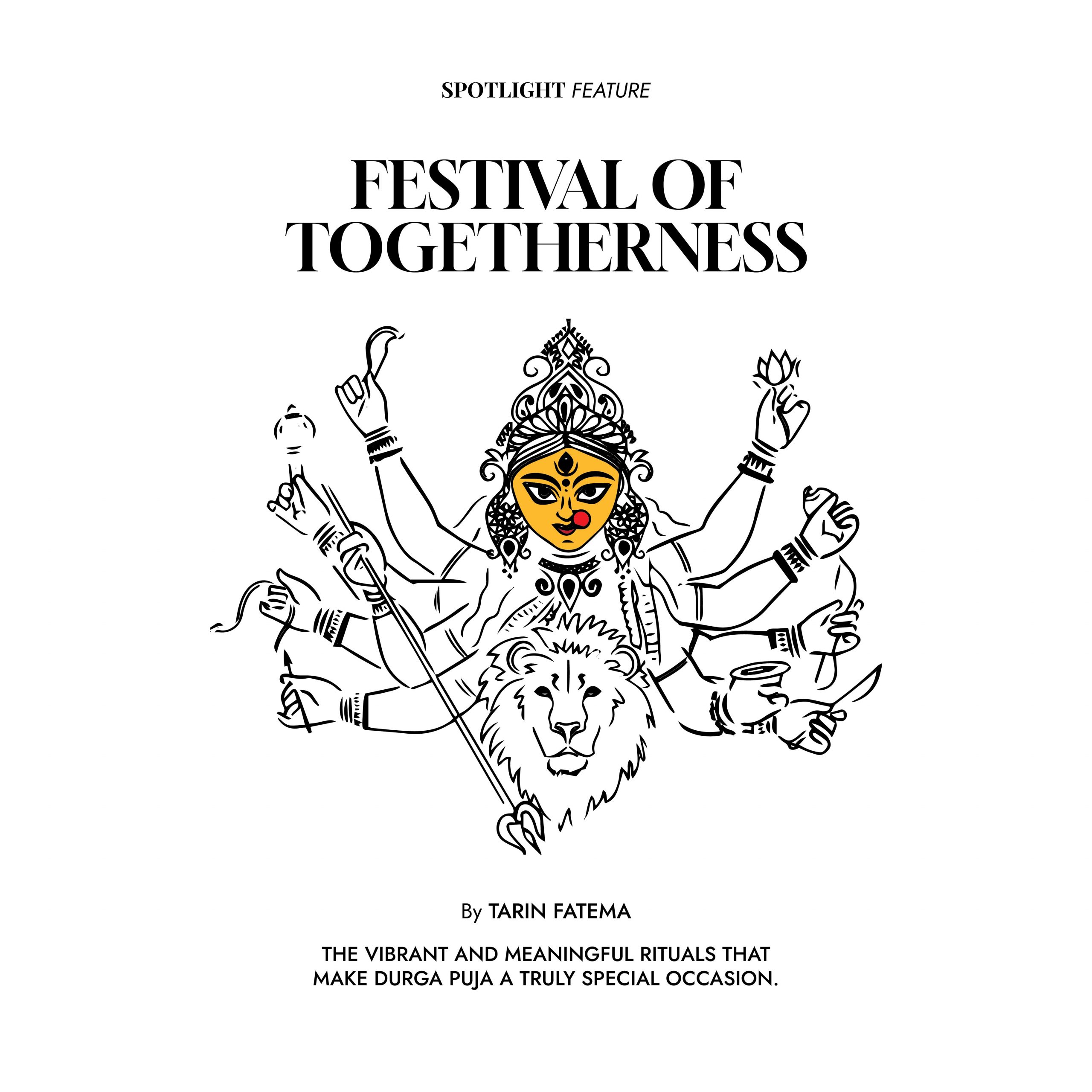
Durga Puja, also known as Sharadiya (autumnal) Durga Utsab, is one of the most widely celebrated religious festivals in Bangladesh. Hindus commemorate Goddess Durga visiting her parents on Earth from her heavenly home, Mount Kailash, accompanied by her children – Ganesha, Kartikeya, Lakshmi, and Saraswati – and their animal mounts. While she is worshipped as a demon-slayer, Durga is surrounded by her loving family, symbolising the battle between good and evil in which the dark forces ultimately succumb to the divine.
This year, Durga Puja begins on October 9. Though it is a 10-day festival, the last five days are considered to be the most significant ones. Devotees celebrate the victory of the goddess through these cherished rituals.
Kathamo
The festivities begin with Kathamo Puja or Khuti Puja, a custom celebrating the day when idol artisans start the sculpting process. Friends and family exchange gifts.
Bodhan
On the eve of Shashthi, the idol of Durga is unveiled. Bodhan is performed to awaken the idol, officially inaugurating the festival at all puja mandaps that evening.
Nabapatrika Snan
Nine plants, led by a banana plant, are tied together as Nabapatrika (nine leaves). They represent the nine forms of Shakti (female power). Nabapatrika is bathed in the river, wrapped in a sari, and placed near Ganesha. It is also called Kola Bou (banana bride).
Anjali
While priests perform rituals, everyone shows respect through Pushpanjali or Anjali, which occurs on Saptami, Ashtami, and Navami, with a specific morning time announced for the offering. People fast until they perform Anjali. Devotees bathe, wear new clothes, gather before Durga, and hold flowers and bel leaves. They repeat a mantra after the priest and throw flowers at Her. Typically, only vegetarian food is eaten on Saptami and Ashtami. The feast on Shaptami serves as a prelude to the celebrations, incorporating special ingredients into regular meals, such as a dash of ghee or an extra dose of paanch phoron.
Kumari Puja
On Ashtami, prepubescent girls are worshipped as Durga’s living form. Dressed beautifully, they share the stage with the Goddess. It is customary to wash and clean the feet of these young girls as a mark of respect for the Goddess and to offer new clothes as gifts from the devotees.
Sandhi Puja
Sandhi Puja takes place at the transition between two periods – at the end of Ashtami and the beginning of Navami. During these hours, Durga is worshipped in her fierce Chamunda form. One hundred and eight lamps are lit. The priest chants, and drummers play a frenzied beat. Animal sacrifice used to be customary but is now mostly symbolic with vegetables.
Dhunuchi Naach
On Navami evening, people hold clay pots with burning charcoal and dance to dhaak beats. Some balance pots on their heads or teeth. Women now also participate in this ritual, which was once mostly dominated by men. The bhog of Navami’s noon is called Raajbhog, which is usually khichuri, served with a variety of bhaji and bora such as Fulkopi-bora, Begun-bora, Alu-bhaja, Chholar dal, and more.
Sindur Khela
On Dashami, devotees bid farewell to Durga before her immersion in the river. One of the rituals of this day is Sindur Khela, where married women (but not widows) offer vermillion and sweets to the Goddess. After that, they smear each other with vermillion. Recently, some women have questioned the custom of excluding widows from the festival.
Bisarjan
Durga and her children are carried out for immersion in the river on Bisarjan, signifying her return to her in-laws’ house in Mount Kailash. Some old households carry the idols on their shoulders, while most use trucks to take them to the riverbank. The idols are placed on a boat and immersed in the middle of the river. Idols from puja mandaps in and around Dhaka are immersed in the Buriganga and the Turag. In Chattogram, idols are immersed in the Bay in the port city’s Patenga and Khalurghat areas.
Bijoya
Bijoya marks the end of the festival. Young people touch elders’ feet to seek blessings. People of the same age perform Kolakuli, an act of hugging. Special sweets, like naru, are distributed.
In recent months, we have witnessed a remarkable display of solidarity among Bangladeshis, regardless of class or religion. People from all walks of life have come together to address the needs of the country and its citizens. This year, various temple committees in Barisal have allocated part of their Durga Puja expenses to flood victims in Feni and Comilla. Many have decided to set up a fund for the flood victims by reducing the cost of decorations and other Puja celebrations. This spirit of togetherness truly reflects the values of the festival. As we celebrate Durga Puja, let us remember the importance of inclusivity and unity for a better society.
